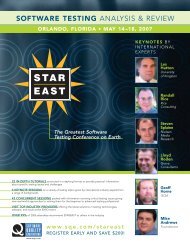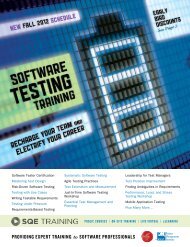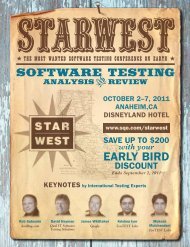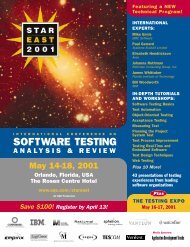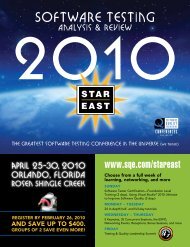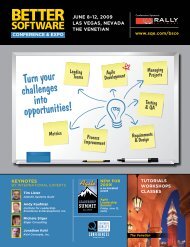concurrent classeswednesday, november 11, 10:00 a.m.W1 <strong>Agile</strong> ManagementPrincipled Agility: The Principles Behindthe <strong>Practices</strong>Mitch Lacey, Independent ConsultantIn Scrum, the product owner manages the product backlog—seems simple enough. But what principles are required to makeseemingly straightforward agile practices really work? MitchLacey suggests courage, trust, <strong>com</strong>mitment, and simplicity arethose principles. Courage: Do I have the courage to say no tothis stakeholder for the overall benefit of the product? Trust:Can I trust the team to sustain their velocity? Commitment: Areall team members working everyday to improve? Simplicity:Are we doing only the things that bring value to the product?These are real-life questions that agile team members facedaily. It’s not enough to just say you’re agile because youwork in iterations. Truly being agile weaves these principlesinto the fabric of our projects. Join Mitch to learn how he hasapplied these principles in his projects and the failures thathave occurred when the principles were misaligned or absentall together. True agility emerges only when principles andpractices align; learn how to build and maintain that alignment.W2 <strong>Agile</strong> ImplementationThe Scrum Product Owner DemystifiedJeff Patton, Independent ConsultantA Scrum product owner’s job is challenging, to say the least.Unfortunately, the specific concepts and techniques requiredto succeed often aren’t spelled out in books and trainingclasses. And being referred to—in Scrum jargon—as “the singlewringable neck” is enough to discourage anyone from signingup for the job. While there’s no silver bullet, Jeff Patton helps fillyour Scrum tool-kit with valuable approaches that help productowners succeed: the basics of collaborative discovery sessionsto identify business and user goals; how to create effective userstories for better planning; how to split and thin user storiesto support iterative/incremental development; approaches forreducing the risk of late delivery; and techniques for keepingusers, stakeholders, and the team involved from inceptionthrough delivery. Jeff knits all of this into a useful productowner’s practice map for you to take back for yourself or forthe product owner in your life.W3 Testing & QualitySeven Key Factors for <strong>Agile</strong> TestingSuccessLisa Crispin, Ultimate Software<strong>Agile</strong> development presents unique challenges for testersand test teams. Working in short iterations, often withlimited written requirements, agile development teams canleave traditional testers behind. Common testing-relatedactivities—such as user acceptance testing, testing interproductrelationships, and installation testing—require differentapproaches to work within agile projects. Lisa Crispin presentsseven key factors for testing success within agile projects—using a whole team approach, adopting an agile mindset,automating regression testing, collaborating with customers,providing and obtaining feedback, looking at the big picture,and building a foundation of core agile practices. Learn how toover<strong>com</strong>e cultural and organizational obstacles to successfultesting and discover the critical factors for delivering maximumvalue to your business.W4 <strong>Agile</strong> TechniquesUser Stories for <strong>Agile</strong> RequirementsMike Cohn, Mountain Goat SoftwareExpressing requirements as user stories is one of the mostbroadly applicable techniques introduced by the agileprocesses. User stories are an effective approach on all timeconstrained projects and are a great way to introduce a bit ofagility to any project. Mike Cohn describes the six attributesof good stories—independent, negotiable, valuable, estimable,sized appropriately, and testable. Explore how user storieshelp a team shift from more documents to more discussion,encouraging the right mix of both. Learn practical, proventechniques for gathering user stories. Discuss how much workshould be done on a user story in advance and by whom andsee why a just-in-time, just-enough approach aids a teamin be<strong>com</strong>ing agile. Discover the relationship between userstories, epics, themes, and conditions of satisfaction. Leavewith a project-proven template for writing user stories and beprepared to put this powerful technique to use immediately.W5 Special TopicsDebug Your MindAndy Hunt, The Pragmatic ProgrammersEvery day, we make important decisions and try to solve criticalproblems in our work. Unfortunately, our decision-making andproblem-solving processes often are based on a faulty memoryand our emotional state at the time. We tend to ignore crucialfacts and fixate on irrelevant details because of where and whenthey occur, or whether they are brightly colored—especially ifthey are brightly colored. Join Andy Hunt as he shares conceptsfrom his popular book Pragmatic Thinking and Learning andexplores the <strong>com</strong>mon cognitive biases that can dramaticallyaffect your decision-making and problem-solving skills. Learnwhy most predictions are wrong from the start and how youcan guard against false assumptions. Discover aspects ofcontext which can subtly affect you, including generationalaffinity and personality tendencies. Find out why your ownbrain’s legacy hardware can work against you, and learn how torecognize and stop that when it happens.“I’ve attended some other types ofconferences and this has been by farthe best. The speakers were great,the food, the ac<strong>com</strong>modations, thetutorials, and the set-up. Can’t waituntil next year to attend!”— Chasity Johnson, Product Manager/Project Manager,MAP Software18Call 888.268.8770 or 904.278.0524 to register • WWW.<strong>SQE</strong>.COM/ADPREG
concurrent classesMONDAY, may 16, 8:30-5:00wednesDAY, november 11, 12:45 p.m.W6 <strong>Agile</strong> ManagementRightsizing Your Project in a DownEconomyMichael Mah, QSM AssociatesIn tough times, both shoes drop simultaneously and “scarcitythinking” takes over in senior executives, managers, anddevelopment teams. In this environment, dysfunction can wreakhavoc on your projects in the form of scope greed, death-marchdeadlines, and budget cuts. Often, the tendency is to say “yes”to impossible dates, take on too much, suffer the budget cuts,and pray that heroics might save the day. This is a disasterwaiting to happen. It takes a skillful manager to “rightsize”critical projects—right team, right scope, right dates—at thebeginning. Scarcity thinking threatens all three. Michael Mahdescribes how to lead difficult conversations and discuss the“undiscussables.” He shares how to artfully frame trade-offs forstakeholders to set priorities. Learn how to get buy-in by usinga blend of <strong>com</strong>mon sense, essential measurement concepts, andrules of software estimation. Whether you’re agile, waterfall,or offshore, discover information you need to make the rightchoices and gain the support of your organization.W7 <strong>Agile</strong> ImplementationThe Power of RetrospectivesLinda Rising, Independent ConsultantOne principle in the <strong>Agile</strong> Manifesto states, “At regular intervals,the team reflects on how to be<strong>com</strong>e more effective, thentunes and adjusts its behavior accordingly.” Retrospectivesare a powerful, repeatable tool to help your team continuouslylearn and improve. Linda Rising shares techniques for projectretrospectives to help teams discover what they’re doingwell and identify what should be done differently. Not fingerpointing or blaming sessions, retrospectives are structuredinteractions in which team members reflect on the past inorder to be<strong>com</strong>e more effective in the future. Linda shares herexperiences with leading retrospectives—both successful andunsuccessful. Learn ways to apply her positive experiencesand a proven retrospective model to your projects. By takingthe time to reflect and proactively determine what should bedone differently in the next iteration, release, or project, yourteam will embody one of the important principles of the <strong>Agile</strong>Manifesto and help your <strong>com</strong>pany be<strong>com</strong>e a true “learningorganization.”W8 Testing & QualityDealing with Defects: The <strong>Agile</strong> WayJanet Gregory, DragonFireIn agile development, software defects are everyone’sresponsibility. One tenet of agile is that defects should be fixed“as soon as possible” rather than documented as an inventoryof “stuff” that doesn’t work yet. Janet Gregory examines thesometimes vexing question agile teams have for dealing witha defect—should we “fix it now and forget it,” “fix it now andtrack it,” or “record and track it?” She explores why, regardlessof which choice is made, you should write a test case to verifythe fix is correct. Find out how those test cases can be<strong>com</strong>ea valuable record about defect history. Learn ways to trackdefects in a simple system to help the agile team discoverprocess problems and potential improvement opportunities. Bydealing with defects effectively, your team will be able to shiftits focus from defect repair toward defect prevention.<strong>Conference</strong> Venue: Rosen Shingle CreekW9 <strong>Agile</strong> TechniquesDetermining Business ValueKen Pugh, Net ObjectivesAgility focuses on delivering business value to the customersas rapidly as possible, and user stories are a <strong>com</strong>mon wayto describe the features and functions that define valueincrementally. However, to concentrate on delivering mostbusiness value earlier in the project, we must determine andassign the relative business value to each of those stories.Through lecture and interactive exercises, Ken Pugh presentstwo methods for quickly estimating and assigning businessvalue for features and stories. Ken explains the relationshipsbetween business value estimates and story point estimates,and how to chart business value for iteration reviews. Kendemonstrates what estimates really represent in both dollarsand time. On a larger scale, he shows you how to use businessvalue assessment as a portfolio management tool to prioritizefeature development across several projects. Learn howbusiness value can help both customers and developers focuson the most important requirements and needs.W10 Special TopicsCMMI ® or <strong>Agile</strong>: Why Not Embrace Both?Hillel Glazer, Entinex, Inc.<strong>Agile</strong> development methods and CMMI ® best practices areoften perceived to be in conflict with each other. Some evenargue that the <strong>Agile</strong> Manifesto was largely a counterresponse tothe original CMM ® . Hillel Glazer explores ways that CMMI ® andagile champions can work together to derive benefit from bothapproaches to dramatically improve business performance. Armyourself with the knowledge to address any <strong>Agile</strong>-CMMI ® riftwithin your organization and learn ways to benefit from bothpractices. Hillel fills in some of the missing details that led to theoriginal perceived conflict and discovers that CMMI ® is missing<strong>com</strong>ponents that agile provides and agile is missing <strong>com</strong>ponentsthat CMMI ® provides. He presents examples of how CMMI ®can help propagate agile ideas and propel them toward fullyoptimized performance levels. In addition, he shares an exampleof how to use systems engineering to strike the appropriate<strong>com</strong>promise between “extreme” agile and “extreme” CMMI ® sothat, in the middle, they can interoperate effectively.CMMI ® and CMM ® are registered trademarks of Carnegie Mellon University.Call 888.268.8770 or 904.278.0524 to register • WWW.<strong>SQE</strong>.COM/ADPREG19
- Page 2: Agile DevelopmentPractices Conferen
- Page 5 and 6: wednesday, november 118:309:4510:00
- Page 7 and 8: conference speakersKeynoteSpeakerTu
- Page 9 and 10: pre-conference tutorialsMONDAY, nov
- Page 11 and 12: pre-conference tutorialsTUESDAY, no
- Page 13 and 14: pre-conference tutorialsTUESDAY, no
- Page 15 and 16: Agile Testing Workshop Sessionsmond
- Page 17: keynote sessionsMONDAY, may 16, 8:3
- Page 21 and 22: concurrent classesMONDAY, may 16, 8
- Page 23 and 24: concurrent classesMONDAY, may 16, 8
- Page 25 and 26: Agile Leadership Summit Sessionsfri
- Page 27 and 28: sponsors and exhibitorsconference s
- Page 29 and 30: Lean-Agile ScrumMaster TrainingNew
- Page 31 and 32: agile development practices Registr



